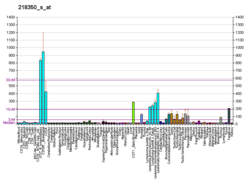Cell cycle control
Geminin is absent during G1 phase and accumulates through S, G2 phase and M phases of the cell cycle. Geminin levels drop at the metaphase-anaphase transition of mitosis when it is degraded by the anaphase-promoting complex. [8]
S phase
During S phase, geminin is a negative regulator of DNA replication. In many cancer cell lines, inhibition of geminin by RNA interference results in re-replication of portions of the genome, which leads to aneuploidy. In these cell lines, geminin knockdown leads to markedly slowed growth and apoptosis within several days. [10] However, the same is not true for primary and immortalized human cell lines, where other mechanisms exists to prevent DNA re-replication. [10] Since geminin knockdown leads to cell death in many cancer cell lines but not primary cell lines, it has been proposed as a potential therapeutic target for cancer treatment. [10]
Mitosis
At the start of the S-phase until late mitosis, geminin inhibits the replication factor Cdt1, preventing the assembly of the pre-replication complex. In early G1, the anaphase promoting complex triggers its destruction through ubiquitination.
Geminin, therefore, is an important player in ensuring that exactly one round of replication occurs during each cell cycle.
Developmental control
Geminin promotes early neural fate commitment by hyperacetylating chromatin. [11] This effect allows neural genes to be accessible for transcription, promoting the expression of these genes. Ultimately, geminin allows cells uncommitted to any particular lineage to acquire neural characteristics.
Geminin has also been shown to interact with the SWI/SNF chromatin remodeling complex. [12] In neural precursor cells, high levels of geminin prevent terminal differentiation. When the interaction between geminin and SWI/SNF is eliminated, geminin's inhibition to this process is eliminated and neural precursors are allowed to differentiate.







